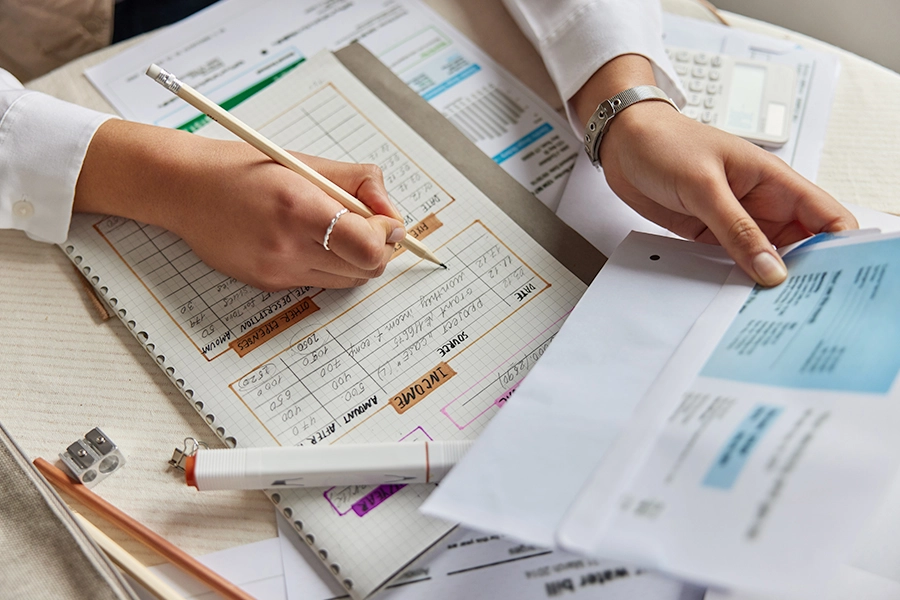Understanding your payslip is so important as you could be on the wrong tax code and be paying the wrong amount of tax for months without being aware. Once you are aware of how tax codes work, you can then make sure yours is correct and ask for it to be amended if needed.
Often, people also don’t check whether their NI, pension or student loan deductions are correct either, and whilst errors on these deductions are less common, it’s vital to be able to check the right amounts are deducted.
What is a tax code?
Tax codes are usually made up of three or four numbers and one letter, for example, 1234L.
Your tax code is used by your employer’s payroll processor to work out how much Income Tax or PAYE to deduct from your pay for your employer to pay to HMRC. Most people are entitled to a personal allowance, which is currently £12,570 per year for the 2023/24 tax year. Most tax codes are made by taking the personal allowance, deducting the 0 at the end and adding an L, meaning most people have a tax code of 1257L.
When employees have benefits in kind or allowable expenses, these can be adjusted for within the tax code, so that the employee pays the correct amount of tax through PAYE without needing to do a self-assessment tax return.
Under or overpaid tax can also be collected or paid through an adjusted tax code.
However, HMRC can and do get tax codes wrong, often including out-of-date information in them, so it’s very important to check yours is correct.
Where can I find my tax code?
Tax codes can be found on your payslip, on a ‘Tax Code Notice’ letter from HMRC if you get one, by contacting HMRC or by checking your tax code for the current year online through your personal tax account.
So, what do the letters mean in some tax codes?
L – you’re entitled to the standard tax-free Personal Allowance. The Personal Allowance can then be reduced for Benefits in Kind or increased for allowable expenses.
M – Marriage Allowance – you’ve received a transfer of 10% of your partner’s Personal Allowance
N – Marriage Allowance: you’ve transferred 10% of your Personal Allowance to your partner
T – HMRC needs to review some items with the employee
BR – all income in this employment will be taxed at the basic rate of 20%, which usually means you have another job where you earn over the Personal Allowance and are claiming Personal Allowance in that job.
NT – means no tax is to be deducted. This is quite unusual and used in very specific circumstances.
0T – There is no Personal Allowance available. This can occur if you have not given your employer your P45 from a previous job all your Personal Allowance is used up.
D0 – All your income from this job or pension is taxed at the higher rate of 40% – usually used if you’ve got more than one job or pension.
D1 – All your income from this job or pension is taxed at the additional rate of 45% – usually used if you’ve got more than one job or pension.
K – If your deductions for benefits in kind are greater than your Personal Allowance, then you will be issued with a code beginning with a K. If you add a 0 to the end of the number after the K, this is the amount that needs to be added to your taxable income before deductions are calculated. For example, a code of K150 means that £1,500 needs to your salary to work out how much the taxable income is.
W1/M1 at the end – This is what HMRC refer to as an emergency tax code. This means that earnings you have had in the tax year so far are not being taken into account when your tax is being calculated, and it is just being worked out on what you were paid in that one period.
Why might my tax code be incorrect?
- You have changed jobs recently, and HMRC may believe that you have two jobs, so they have put you on an emergency tax code which removes your personal allowance.
- You’ve recently changed from self-employed to employed or part-time to full-time.
- You have more than one income stream or pension, for example you have two jobs.
- Your employer was using the wrong code.
- You have started or have stopped receiving a benefit in kind from your employer, such as a company car or health insurance.
- You receive or have stopped receiving certain benefits, such as benefits from your job or taxable state benefits, or you claim marriage Allowance.
- You claim expenses that you get tax relief on.
- You’ve recently retired.
So, how do I check the PAYE on my payslip is correct?
If you’re a basic rate taxpayer (earn under £50,270 per year) and are on an L tax code, you can take the numbers before the L, add a 0 and this is your annual tax free amount. If you’re paid monthly, divide this by 12 and to work out the monthly tax free amount. The remainder will then be taxed at 20%.
For example, if you are paid a salary of £24,000 and your tax code is 1257L, the PAYE you should be deducted each month is:
Monthly gross pay – £2,000.00
Personal Allowance – £1,047.50
PAYE – (£2,000 – £1,047.50) x 20% = £190.50
So, what you can you do if you think you have been taxed incorrectly?
In some circumstances, HMRC will recognise that you have under/overpaid tax and will issue a new tax code to be applied the tax will be adjusted in the next pay period. However, sometimes employees will need to contact HMRC to amend their tax code. This can be done by logging into your government gateway online account or by calling HMRC.
National Insurance
From 6th January 2024, National Insurance for employees went down from 12% to 10%. NI is not deducted from your whole salary though, you get a tax free amount of £12,570 per year or £1,048 per month.
So if your salary is £24,000, you will pay NI on any earnings over £1,048 per month which is:
(£2,000 – £1,048) x 10% = £95.20
Pensions
If you’re over 22 and earn over £10k per year then you will be auto-enrolled into a pension scheme by your employer. By law, you and your employer must contribute into your pension scheme, unless you opt out. Schemes and deduction amounts vary but a common basic pension scheme has 5% of qualifying earnings paid by the employee (tax relief at source) and 3% from the employer. Qualifying earnings are monthly earnings between £520 and £4,189. If you want to contribute more than this to save towards your retirement, speak to your employer and they can increase your deduction.
So if you earn £24,000 per year and are in a basic pension scheme as above, you could expect your contribution to be:
(£2,000 – £520) x 5% x 80% = £59.20 – the 80% is because the government contributes 20% as tax relief
The employer would pay a contribution of:
(£2,000 – £520) x 3% = £44.40
Giving a total monthly amount added to your pension pot of:
£59.20 employee cont’n + £14.80 government con’n + £44.40 employer cont’n = £118.40
Student Loan
If you received a student loan whilst studying, you will be required to pay this back when you earn over the threshold for your payment plan. The current thresholds are that those on Plan 1 need to earn over £22,015, for those on Plan 2 it is £27,295 and those on Plan 4 will need to earn £27,660. When you check your payslip, you should see a 9% deduction of your income over the relevant threshold if you’re on Plan 1, 2 or 4.
If you have an additional Postgraduate Loan plan, then you will see an additional 6% deduction on earnings over £21,000.
Being able to understand your payslip is so important to make sure that you are paying the correct amount of tax and other deductions. It can make a massive difference if errors carry on over months without being resolved and it is amazing how many people don’t understand what they are being paid or deducted.
If you do have any questions please contact us via info@future-cloud.co.uk.




